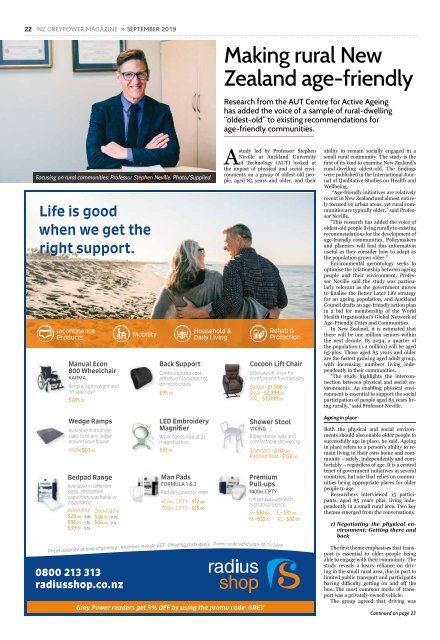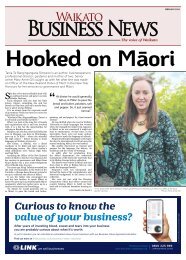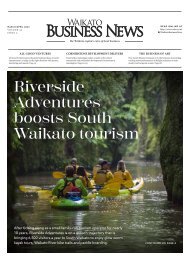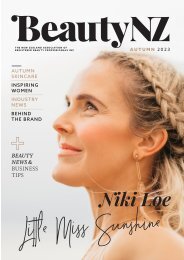Grey Power September 2019
The Grey Power Magazine is a prime national news source for its readers – New Zealand men and women over 50. Circulated quarterly to more than 68,000 members, Grey Power Magazine reports on the policies of the Grey Power Federation, and the concerns of the elderly, backgrounding and interpreting official decisions which affect their lives.
The Grey Power Magazine is a prime national news source for its readers – New Zealand men and women over 50. Circulated quarterly to more than 68,000 members, Grey Power Magazine reports on the policies of the Grey Power Federation, and the concerns of the elderly, backgrounding and interpreting official decisions which affect their lives.
Create successful ePaper yourself
Turn your PDF publications into a flip-book with our unique Google optimized e-Paper software.
22<br />
NZ GREYPOWER MAGAZINE » SEPTEMBER <strong>2019</strong><br />
Making rural New<br />
Zealand age-friendly<br />
Research from the AUT Centre for Active Ageing<br />
has added the voice of a sample of rural-dwelling<br />
“oldest-old” to existing recommendations for<br />
age-friendly communities.<br />
Focusing on rural communities: Professor Stephen Neville. Photo/Supplied.<br />
Life is good<br />
when we get the<br />
right support.<br />
Incontinence<br />
Products<br />
Manual Econ<br />
800 Wheelchair<br />
KARMA<br />
Simple, lightweight and<br />
on sale now!<br />
$785.00<br />
Mobility<br />
Back Support<br />
Contoured and costeffective<br />
foam that fits<br />
on most chairs.<br />
$95.00<br />
Household &<br />
Daily Living<br />
A<br />
study led by Professor Stephen<br />
Neville at Auckland University<br />
of Technology (AUT) looked at<br />
the impact of physical and social environments<br />
on a group of oldest-old people,<br />
aged 85 years and older, and their<br />
Rehab &<br />
Protection<br />
Cocoon Lift Chair<br />
Ultimate lift chair for<br />
comfort and functionality.<br />
Single - $1,998.00<br />
Dual - $2,399.00<br />
XXL - $3,099.00<br />
ability to remain socially engaged in a<br />
small rural community. The study is the<br />
first of its kind to examine New Zealand’s<br />
rural-dwelling oldest-old. The findings<br />
were published in the International Journal<br />
of Qualitative Studies on Health and<br />
Wellbeing.<br />
“Age-friendly initiatives are relatively<br />
recent in New Zealand and almost entirely<br />
focused on urban areas, yet rural communities<br />
are typically older,” said Professor<br />
Neville.<br />
“This research has added the voice of<br />
oldest-old people living rurally to existing<br />
recommendations for the development of<br />
age-friendly communities. Policymakers<br />
and planners will find this information<br />
useful as they consider how to adapt as<br />
the population grows older.”<br />
Environmental gerontology seeks to<br />
optimise the relationship between ageing<br />
people and their environment. Professor<br />
Neville said the study was particularly<br />
relevant as the government moves<br />
to finalise the Better Later Life strategy<br />
for an ageing population, and Auckland<br />
Council drafts an age-friendly action plan<br />
in a bid for membership of the World<br />
Health Organisation’s Global Network of<br />
Age-Friendly Cities and Communities.<br />
In New Zealand, it is estimated that<br />
there will be one million seniors within<br />
the next decade. By 2034, a quarter of<br />
the population (1.2 million) will be aged<br />
65-plus. Those aged 85 years and older<br />
are the fastest growing aged adult group,<br />
with increasing numbers living independently<br />
in their communities.<br />
“The study highlights the interconnection<br />
between physical and social environments.<br />
An enabling physical environment<br />
is essential to support the social<br />
participation of people aged 85 years living<br />
rurally,” said Professor Neville.<br />
Wedge Ramps<br />
Available in multiple<br />
sizes to fit any ledge<br />
around your house.<br />
FROM $63.00<br />
Bedpad Range<br />
Available in different<br />
sizes, absorption<br />
capacities, washable or<br />
disposable.<br />
Washable<br />
$28.00 - 0.8L<br />
$35.00 - 1.5L<br />
$39.00 - 2.5L<br />
Disposable<br />
$38.00 - 0.9L<br />
$46.00 - 2.1L<br />
LED Embroidery<br />
Magnifier<br />
Work hands free at 2x<br />
magnification.<br />
$33.00<br />
Man Pads<br />
FORMULA 1 & 2<br />
Pad designed for men.<br />
450ML CPTY - $12.00<br />
700ML CPTY - $15.00<br />
Shower Stool<br />
VIKING<br />
Enjoy stable, safe and<br />
comfortable showering.<br />
Standard - $130.00<br />
Padded Seat - $138.00<br />
Premium<br />
Pull-ups<br />
1400ML CPTY<br />
Unisex pull-ups with<br />
high absorbency.<br />
S - $30.00<br />
M - $30.00<br />
L - $31.00<br />
XL - $32.00<br />
Ageing in place<br />
Both the physical and social environments<br />
should also enable older people to<br />
successfully age in place, he said. Ageing<br />
in place refers to a person’s ability to remain<br />
living in their own home and community<br />
– safely, independently and comfortably<br />
– regardless of age. It is a central<br />
tenet of government initiatives in several<br />
countries, but one that relies on communities<br />
being appropriate places for older<br />
people to age.<br />
Researchers interviewed 15 participants,<br />
aged 85 years plus, living independently<br />
in a small rural area. Two key<br />
themes emerged from the conversations.<br />
1) Negotiating the physical environment:<br />
Getting there and<br />
back<br />
Prices accurate at time of printing . All prices include GST . Shipping costs apply . Promo code valid until 30/11/<strong>2019</strong><br />
0800 213 313<br />
radiusshop.co.nz<br />
<strong>Grey</strong> <strong>Power</strong> readers get 5% OFF by using the promo code: GREY<br />
`<br />
`<br />
FREE SHIPPING!<br />
The first theme emphasises that transport<br />
is essential to older people being<br />
able to engage with their community. The<br />
study reveals a heavy reliance on driving<br />
in the small rural area, due in part to<br />
limited public transport and participants<br />
having difficulty getting on and off the<br />
bus. The most common mode of transport<br />
was a privately-owned vehicle.<br />
The group agreed that driving was<br />
Continued on page 23


















